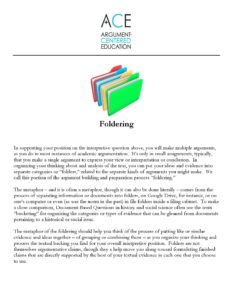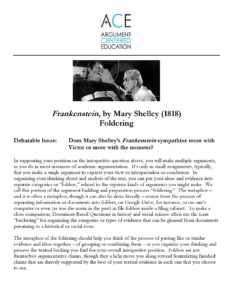
Foldering Frankenstein
When students support their position on a debatable issue they will most often make multiple arguments. Most instances of academic argumentation require the writer or speaker to produce more than one reason that their position is valid; it’s only in small assignments, typically, that only a single argument is required to express and support a viewpoint or interpretation or conclusion. In organizing their thinking about and analysis of a text or a set of documents or a data set, students can put their ideas and evidence into separate categories or “folders,” related to the separate kinds of arguments they might make. We call this portion of the argument building and preparation process “foldering.”

The metaphor – and it is often a metaphor, though it can also be done literally – comes from the process of separating information or documents into folders, on Google Drive, for instance, or on one’s computer or even (as was a norm in the past) in file folders inside a filing cabinet. To make a close, current comparison, Document-Based Questions in history and social science often use the term “bucketing” for organizing the categories or types of evidence that can be gleaned from documents pertaining to a historical or social issue. Foldering and bucketing are near-synonyms.
The metaphor of the foldering should help students think of the process of putting like or similar evidence and ideas together – of grouping or combining them – as they organize their thinking, and they process the textual backing that they find for their overall interpretive position. Folders are not themselves argumentative claims, though they a help move the student along toward formulating finished claims that are directly supported by the best of their textual evidence.
Foldering and Frankenstein
One of Argument-Centered Education’s partners is implementing an argument-centered unit on Mary Shelley’s 1818 Romantic classic, Frankenstein. The issue guiding summative argumentation in the unit is
Does Mary Shelley’s Frankenstein sympathize more with Victor or more with the monster?
For the debate that these classes will be having, and for the argument essay that students will be writing subsequent to the debate, students are provided these folder labels to choose from in building and making their arguments.
If they are arguing that the novel sympathizes more with Victor, you must choose two folders from which to build and make your two arguments, organizing quoted and summarized passages and analysis into these folders:

Pursuit of scientific knowledge

Ambition to become extra-ordinary, transcendent

Individualism

The emotional wounding of lost love or crushing disappointment

Moral autonomy (the monster has moral responsibility for his own actions)
If students are arguing that the novel sympathizes more with the monster, they must choose two folders from which to build and make their two arguments, organizing quoted and summarized passages and analysis into these folders.

Intense emotion/passion

Nature as a spiritual force

The mystery and allure of the gothic

Rebellion against unfairness or oppression

The romanticism of isolation


